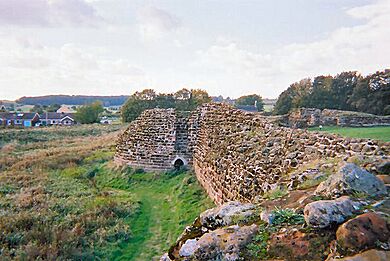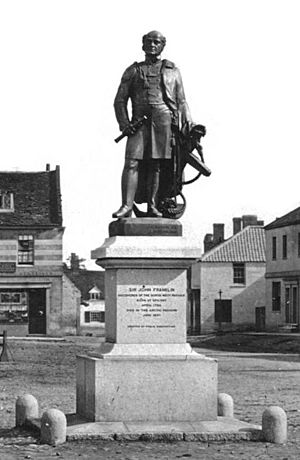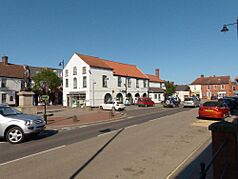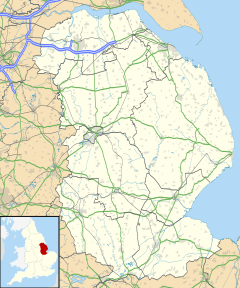Spilsby facts for kids
Quick facts for kids Spilsby |
|
|---|---|
|
Clockwise from top: Spilsby Old Town Hall, the Grade I listed St James Church and High Street |
|
| Population | 3,677 (Parish/Ward, 2021) |
| OS grid reference | TF4066 |
| • London | 120 mi (190 km) S |
| District | |
| Shire county | |
| Region | |
| Country | England |
| Sovereign state | United Kingdom |
| Post town | SPILSBY |
| Postcode district | PE23 |
| Dialling code | 01790 |
| Police | Lincolnshire |
| Fire | Lincolnshire |
| Ambulance | East Midlands |
| EU Parliament | East Midlands |
| UK Parliament |
|
Spilsby is a small market town in Lincolnshire, England. It is found in the East Lindsey area. The town is close to the main A16. It is about 33 miles (53 km) east of Lincoln. Spilsby is also 17 miles (27 km) north-east of Boston. It is 13 miles (21 km) north-west of Skegness. The town sits at the southern edge of the Lincolnshire Wolds. It is also north of the Fenlands.
Spilsby has been a country market town for over 700 years. It has not grown much since the early 1800s. The town centre has small shops and places to eat. You can find supermarkets, banks, newsagents, and bakeries. There are also butchers, jewellers, and clothing stores. Plus, there are pubs, cafes, and takeaways.
In the middle of town is an open square. This is the traditional market place. Four main streets spread out from here. Markets happen every Monday. Spilsby is in a farming area. So, much of the market food is local. This includes fresh vegetables and meat.
In 2001, the town had 2,336 people. By 2011, this grew to 3,045 people.
Contents
History of Spilsby
How Old is Spilsby?
People have lived in the Spilsby area for a very long time. This goes back to prehistoric times. Near West Keal, there is an Iron Age hill fort. This fort and its defenses were built on a hill. They looked over where Spilsby is today.
The Romans visited and lived in the Spilsby area. They were here from the 1st to the 4th century AD. In the 1960s, a dig near Keal Cotes found Roman floor tiles. They also found roof tiles. This showed that a large Roman house was once there. Finds from this site are in the Museum of Lincolnshire Life. In 1849, six Roman funeral urns were found near Fulletby.
Spilsby likely got its name before the 9th century. This was during the time of Danish rule. The name comes from "Spila's-by." By is an old Norse word for "place of dwelling." So, it meant "Spila's village." Spila was likely a local Viking leader. The town was called "Spilesbei" in the Domesday Book of 1086. Back then, it was mostly a large farm.
Markets and Old Buildings
In 1255, a special permission was given to John de Beke. He could hold a market in Spilsby every Monday. He could also hold a three-day fair in July. Four years later, in 1259, he got permission for a Christmas fair. This fair lasted three days in December. Later, in 1302, Robert de Willoughby got permission for the market and fair. He was the Lord of the Manor. A copy of this permission is in the parish church.
At the east end of the town centre is a medieval monument. It is called a buttercross. Historians think it is from the 1300s or 1500s. The steps of these monuments were used by traders. They would display goods like milk, cheese, and butter.
The Old Town Hall stands in the market place. It has been used as a store and petrol station more recently. In the 1700s, it held town offices and a small courtroom. It also had the town jail upstairs. The ground floor was open. It was used for trading grain and for market stalls. This kept traders safe from bad weather.
The Manor of Eresby Estate
The Manor of Eresby included the lands around Spilsby. A common story says William the Conqueror gave these lands to Walter de Beke. But records show the Bishop of Durham held Spilsby in 1086. Other sources say a different Walter de Bec married Agnes of Tattershall. She brought Spilsby and the Eresby Manor with her. These lands were given to her by William I.
The Beke family owned the manor until the male line ended. Alice, daughter of John Beke, became the owner. The manor then went to Robert de Willoughby. This was through his father's marriage to Alice de Beke. The Willoughby family came from nearby Willoughby in the Marsh. In 1313, Robert became the first Baron Willoughby de Eresby. This family line still exists today.
The first manor house was from the 1300s. It was likely taken down when a new one was built. Pieces of the old house were found in the 1960s. Many old pottery pieces were found near the manor's moat.

A new Eresby manor house was built in 1535. Charles Brandon, 1st Duke of Suffolk, built it. He got the property after marrying Catherine Willoughby. She was only fifteen and inherited the land.
In 1769, the Manor House was destroyed by fire. This happened when the 19th Baron was in charge. A carpenter working in the roof space accidentally started it. A map from 1771 shows the house was 'H' shaped. The grounds had an orangery, cherry orchard, and bowling green. The manor house once had a moat. By 1771, it was a fishing lake.
The local church is St James' Church. It is part of the Church of England. It is built from local Spilsby green sandstone. Parts of it are from the late 1300s. The church has been added to many times. It has important old tombs. The greenstone is soft and takes in water. So, the church was later covered in Lancaster stone. It can hold about 750 people. The churchyard stopped being used for burials in 1884.
In 1349, Sir John de Willoughby built a private chapel. This was to celebrate becoming the 3rd Baron. It was called the Holy Trinity chapel. It had a master and up to twelve priests. In 1550, the family started the King Edward VI Grammar School. The school first taught children in the chapel. About twenty children learned there for sixty years.
The Willoughby family provided a school house in 1611. They changed a farm building for this. In 1839, a new school building was built. This was on its current site. Funds came from the 25th Baron.
Bolingbroke Castle: A Royal Birthplace
Bolingbroke Castle was built near Spilsby after 1220. It was built by Ranulph de Blondeville. He was the Earl of Chester and Lincoln. Henry de Bolingbroke was born here in 1366. He later became King Henry IV at age thirty-two.
The castle was badly damaged during the English Civil War. After the Battle of Winceby in 1643, only the lower outer walls remained. The last part of the castle, the gatehouse, fell down in 1815.

Bolingbroke's walls were also made of Spilsby greenstone. They were shaped like an uneven hexagon. There were round towers on five corners. The gatehouse had two towers. A drawbridge crossed the moat. The moat went around an area about 87 yards (80 m) wide. The walls were 6.5 feet (2 m) thick. They were 16 to 32 feet (5 to 10 m) long. A small door was in the back wall. A market village outside the castle supported the soldiers. It had farms, a friary, and lakes for salmon.
Gunby Hall: A Peaceful Home
Gunby Hall was built in 1700 by Sir Henry Massingberd. This is shown by a date on the west doorway. The large house is still here. It is in beautiful gardens and parkland. The gardens have a blue gazebo. Poet Laureate Alfred, Lord Tennyson lived nearby. He called it "an English home... a haunt of peace." His original words are kept in the hall's library.
During World War II, the Air Ministry wanted to build an airfield at Gunby. This would have meant tearing down the house. The owner, Field Marshal Sir Archibald Montgomery-Massingberd, asked King George VI for help. The Air Ministry changed its plans. RAF Spilsby was built 2 miles (3.2 km) south instead. The runway ended just short of the Gunby estate.
Gunby Hall was given to the National Trust in 1944. It was one of the first big houses given to them. It is open to the public on certain days in summer. It is still a private family home for the rest of the year.
Hundleby: A Nearby Village
Hundleby was an old parish near Spilsby. It has not changed much in size for 200 years. In 1801, it had 218 people. In 1901, it reached 528 people. Most were farm workers. By 1971, the population was 439. It has stayed about the same since then.
Hundleby's Anglican St Mary's church was rebuilt from 1853 to 1855. It could seat about 200 people. The parish could send three children to the free school in Raithby. Hundleby's elementary school was built around 1860. It was made bigger in 1884 for up to 120 children.
The Grace Swan Memorial Cottage Hospital was built in Hundleby. This was in the late 1800s. It had 25 beds for patients. It had an operating room and a maternity unit. It also had a doctor living there. The hospital closed in the 1990s. The building is now a local health centre.
Spilsby's Poor Law Union had a workhouse in Hundleby. It was built in 1838. In 1870, it had 280 residents. The workhouse later became Spilsby's Gables Hospital. This hospital was torn down in the early 2000s. New houses were built there.
Spilsby in the 1800s
In 1833, a new cemetery was made on Boston Road. It was about one acre. A guide from 1842 called Spilsby "a small, but thriving and well-built market town." It said Spilsby was "pleasantly seated on an eminence." This means it was on a nice hill. From there, it looked over marshes and fens.
In 1839, the King Edward VI Grammar School moved. It went from its 17th-century building to a new one in Spilsby. The old grammar school building was left empty in the 1990s. This was after the two Spilsby secondary schools joined. They became Spilsby High School.
In the mid-1800s, several chapels were built. These were for nonconformist Methodists. This included Wesleyan Methodist and Primitive Methodist chapels. When the Independents built a new chapel in 1866, they used their old one as a Sunday school. The Wesleyans built a chapel in Market Place in 1878.
A prison for the area was built in Spilsby. This was between 1824 and 1826. It was on a site where Spence Street and West End are now. The prison was over 2 acres (0.81 ha). It had a high brick wall and a courthouse in front. It was made bigger in 1869. It then had 85 single cells. The prison was torn down in 1876. Only the front part remained. This part had the sessions house, police station, and town lockup. The Sessions House is now the Spilsby Theatre and Arts Centre.
The town's gasworks were built in 1853. They opened in 1854 on Ashby Road. This brought street and house lighting to Spilsby for the first time. In 1908, a pumping station opened in Hundleby. It had a 75,000-gallon reservoir. This brought tap water to homes in Spilsby for the first time.
In 1892, the Spilsby Pavilion opened. Another room opened in 1896. Each room could hold 300 to 400 people. The Pavilion was advertised for "dancing parties and smoking concerts." The Masonic Lodge and Hall opened in 1913.
The parish had 22 acres (8.9 ha) set aside for "poor land." It owned many homes and a pub. The money from these properties helped the poor.
Railway Connections
A small local railway company built a branch line to Spilsby. It went from Firsby junction. It opened on May 1, 1868. The line was just over 4 miles (6.4 km) long. It connected Spilsby to the main line from King's Cross, London to Cleethorpes. The only other station on this line was Halton Holegate Halt.
Building the railway started in March 1867. The local rector, Reverend Rawnsley, cut the first turf. The railway was expected to open quickly. But there were problems with the builders. Some parts of the track had to be replaced. The Great Northern Railway bought the Spilsby & Firsby Railway Company in 1890.
Passenger trains stopped in 1939. A goods service continued for almost 20 years. It carried grain, potatoes, and livestock. Goods like petrol, paraffin, and coal still came by train. The line finally closed on November 30, 1958.
The main station building was torn down in 1965. The engine shed is now used by farm suppliers. New parts have been added. The old railway line in town has been built over. Most of it is now the Vale Industrial Estate. Outside town, you can still see the old track route. It is marked by trees and bushes.
Military History
The Seventh Spilsby Rifle Volunteer Corps was formed in 1860. This was an early part-time army group. It was part of the Volunteer Force. At its biggest, it had about 100 members.
In 1889, the Rifle Volunteer Corps changed its name. It became F Company of the First Volunteer Battalion. It was based in Spilsby.
In 1899, Spilsby's Territorial Force Drill Hall was finished. It was built of red brick. The site also had homes for the army instructors.
In 1912, C Company of the 5th Battalion Lincolnshire Regiment was formed. This was part of the Territorial Force.
Royal Air Force in Spilsby
During the Second World War, RAF Spilsby was built. It was a bomber airfield for Lancaster bombers. It opened on September 20, 1943. Later, the United States Air Force used it. It was a strategic bomber base until 1958. The airfield was finally torn down in the late 1970s. The runways were broken up. Most of the crushed material was used to build the new Humber Bridge.
RAF Spilsby is remembered by a memorial. It stands near Great Steeping. There are also plaques in All Saints' Church, Great Steeping. You can still see outlines of the runways from the air.
Spilsby Air Training Corps started in 1950. It was first part of the Skegness squadron. It became the 2266 Spilsby Squadron ATC in 1952. It closed in 2005 because fewer members joined.
RAF Spilsby was rebuilt in the 1950s. It was a standby base in case of war. It was meant for escort fighters. But it was never used, and no planes ever landed there. The new runway was weak due to water problems.
Governance
Spilsby parish was in the East division of the old Bolingbroke Wapentake. This was in the East Lindsey district. Spilsby is now run by Spilsby Town Council. It is also under East Lindsey District Council.
Spilsby is part of the Louth and Horncastle area for Parliament. The current Member of Parliament (MP) is Victoria Atkins.
Geography
Spilsby is on slightly high ground. It is at the southwest edge of the Lincolnshire Wolds. From Spilsby, you can see a large area of marsh and fen land. This land reaches the North Sea. Spilsby is about 12 miles (19 km) from Skegness.
The Wolds are low hills and steep valleys. They are made of chalk, green limestone, and sandstone rock. These rocks formed in the Cretaceous period. This was when the area was under a shallow warm sea. The Wolds' valleys were shaped during the last ice age. This happened because of ice and melting water.
The Lincolnshire Wolds are a continuation of the Yorkshire Wolds. The River Humber separates them. The fenlands stretch down to Norfolk. They used to be wetlands. They had peat bogs and tidal silt marshes. Most were drained by the late 1800s. This was when Spilsby grew the most.
Water drainage was set up for rivers. It also drained the land between rivers. This was done by areas or districts. Spilsby is in the Witham Fourth District.
Population of Spilsby
How Many People Live Here?
Here are some past population numbers for Spilsby:
- 1801 – 932 people
- 1821 – 1,234 people
- 1841 – 1,434 people
- 1861 – 1,467 people
- 1881 – 1,423 people
- 1911 – 1,464 people
- 1931 – 1,654 people
Recent Census Information
The 2001 census showed 2,336 people lived in Spilsby.
- 47.3% were male and 52.7% were female.
- 26.3% were single, and 47.8% were married.
- 98.6% were White.
The 2011 census showed 3,045 people.
- Number of homes: 1,398
- Average people per home: 2.1
- People in homes: 2,992
- People in shared living: 53
- Area: 500 hectares
- People per hectare: 6.10
The 2021 Census found 3,677 people in Spilsby.
- 98.1% were White.
- 1.9% were from other ethnic groups.
- About 54.8% were Christian.
- 44.2% said they had no religion.
- Less than 1% followed other religions.
Economy
The area around Spilsby is mostly agricultural. This means farming is very important. Tourism is also growing in Spilsby and nearby towns in the Wolds.
Landmarks to See
Spilsby and nearby places have interesting landmarks:
- Gunby Hall: A National Trust property. It is open on certain days in summer.
- The Buttercross monument: An old market monument.
- A statue of Sir John Franklin: A famous explorer.
- Spilsby Theatre and Arts Centre.
- Northcote Heavy Horse Centre.
- Bolingbroke Castle: An old castle ruin.
The Battle of Britain Memorial Flight is near RAF Coningsby. It has flying planes like a Lancaster bomber. It also has five Spitfire and two Hurricane fighters. The Lincolnshire Aviation Heritage Centre is in East Kirkby. This museum remembers the RAF in Lincolnshire during World War II. It has one of the world's last flying Lancaster bombers.
Snipe Dales Nature Reserve and Country Park is next to the historic Civil War battlefield at Winceby.
Education in Spilsby
Schools for Young Children
Rural Pre-Schools
- Bright Sparks Kindergarten – Fen Road, Spilsby
- Nestlings Nursery – Rookery Farm, Little Steeping
- Skendleby Play School – Gunby
Urban Pre-Schools
- Spilsby and Skegness Portage – Eresby Avenue, Spilsby
- Spilsby Playgroup – Woodlands Road, Spilsby
- Totschool Playgroup – Halton Road, Spilsby
Primary Schools
Rural Primary Schools
- Great Steeping Primary School: For boys and girls. About 115 students.
- Halton Holegate C of E Primary School: For boys and girls. About 56 students.
- Partney C of E Primary School: For boys and girls. About 83 students.
- Toynton All Saints' Primary School: For boys and girls. About 92 students.
Urban Primary School
- Spilsby Primary School: For boys and girls. About 254 students.
Secondary Education
King Edward VI Academy is a school for students aged 11 to 18. It is a bi-lateral secondary school. This means it teaches students who passed the 11+ exam and those who didn't. They learn separately but in the same building. This is quite unusual.
The school was formed by joining two older schools. These were King Edward VI Grammar School (opened 1550) and Sir John Franklin Secondary Modern School (opened 1954). They first combined in 1991 as Spilsby High School. In September 2008, a sixth form college was added. This offers education for students over 16.
The original 1837 grammar school building was left empty. It could not be torn down because it was a Grade II listed building. In 2007, the front part was made into a community centre. The back was torn down for new houses.
Special Schools
- Eresby School – Eresby Avenue, Spilsby. This is a special school for children aged 2 to 19.
- The Jane, Lady Franklin School – Spilsby. This is a special school for 11- to 16-year-olds. It has about 45 students.
Religious Sites
- St James' Church – Church of England – Church Street & Boston Road
- Church of Our Lady & the English Martyrs – Catholic – Church Road (opposite Spilsby Theatre)
- Spilsby Methodist Church – (opposite the Buttercross)
- All Saints' Church – Christian Fellowship
- Spilsby Christian Fellowship – Halton Road
Public Services and Shops
Spilsby has many shops and services. You can find cafes, bakeries, florists, and butchers. There are also clothing and furniture stores. It has a special ice cream shop that makes its own ice cream.
Market day is Monday.
There is a large Sainsbury's store and a Co-op. You can also find a doctor's surgery, a dentist, and a post office. The local library is inside the Co-op.
Spilsby has several churches.
The biggest playground is on Boston Road. It has a playing field and a pavilion.
Spilsby has several public houses (pubs). These include The White Hart Inn, The King's Head, The Bell Inn, The Hundleby Inn, The Red Lion, The Nelson Butt Inn, and the George Hotel.
Bus services connect Spilsby to other towns. These include Lincoln, Boston, Skegness, Horncastle, Alford, and Spalding.
Spilsby is in the Lincolnshire Wolds. It is a great place to visit. You can stop here on your way to the seaside. Or you can visit nearby Snipe Dales. There are also fantastic walks in the Wolds.
Media
Local news and TV shows come from BBC Yorkshire and Lincolnshire and ITV Yorkshire. TV signals are received from the Belmont TV transmitter.
Local radio stations include BBC Radio Lincolnshire, Greatest Hits Radio Lincolnshire, and Hits Radio Lincolnshire.
The town is served by local newspapers. These are the Skegness Standard and East Lindsey Target.
Sports and Fun
Spilsby has clubs for football, bowls, and hockey. There is a sports pavilion and playing fields on Ancaster Avenue. The Spilsby Show happens on the playing fields every July. Money raised helps local charities.
Spilsby Town F.C. is a football club started in 1881. The first team plays in the Boston Cropleys Suzuki Premier Division. The Reserve team plays in the first division. Spilsby Town won the Lincolnshire Senior Cup three times. This was in 1881–82, 1882–83, and 1883–84. Between 1880 and 1885, Spilsby Town entered the FA Cup every year. But they could not get past the first round.
Spilsby Juniors Football Club started in 1998. They began with one Under-12 team. The club has grown. It now has four teams, from Under-9s to Under-14s.
Spilsby also has dance and yoga classes. These are held at the High School on Monday nights. Tai chi classes are at the Town Hall on Tuesday evenings.
Twin Towns
Spilsby is twinned with:
- Fresnay-sur-Sarthe, France
- Bassum, Germany
Famous People from Spilsby

- David Gordon Blackbourn (born 1949 in Spilsby) – A historian and professor.
- Sir John Franklin – A Royal Navy captain and polar explorer. He was born in Spilsby in 1786. He died during an expedition to the Arctic in 1847. His statue in Spilsby's town square says he was the "Discoverer of the North West Passage."
- Joel Pott – A musician and songwriter, born in Spilsby.
- Stephen Sackur – A BBC TV journalist, born in Spilsby.
Images for kids
See also
 In Spanish: Spilsby para niños
In Spanish: Spilsby para niños








